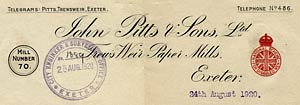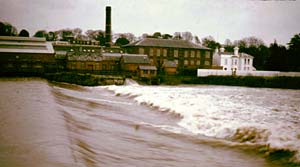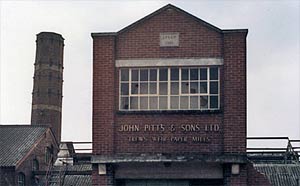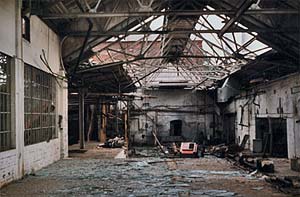
Trews Weir Mill
Page updated 31st May 2010
 On the site of a former
fulling mill that existed in 1633, a cotton mill, named Weir
Field, was opened by Robert Tripping at Trews
Weir in 1793, that
employed 300. By 1801, the partnership of Greenway and Thuiller was
formed to run it, but by 1807, Thuiller was bankrupt and the mill was
for sale. Described as the only cotton mill in the west of England, the
sale advert listed the machinery housed on four floors as 32 water
swift spinning frames, 2 mules, 31 carding machines, 4 carding engines,
3 roving billies, 16 spinning jennies, 141 looms for manufacturing
calicoes and 43 plain and gigger frames. There was also a bleaching
ground and 14 cottages.
On the site of a former
fulling mill that existed in 1633, a cotton mill, named Weir
Field, was opened by Robert Tripping at Trews
Weir in 1793, that
employed 300. By 1801, the partnership of Greenway and Thuiller was
formed to run it, but by 1807, Thuiller was bankrupt and the mill was
for sale. Described as the only cotton mill in the west of England, the
sale advert listed the machinery housed on four floors as 32 water
swift spinning frames, 2 mules, 31 carding machines, 4 carding engines,
3 roving billies, 16 spinning jennies, 141 looms for manufacturing
calicoes and 43 plain and gigger frames. There was also a bleaching
ground and 14 cottages.
Nearby is what is colloquially known as the 'Match Factory', although it never manufactured a single match. The building displays the date 1774 and was used for producing flax. There was no wheel at the building, so it is probable it was an attempt to produce the raw material to be woven in the cotton factory.
The cotton mill proved to be unsuccessful, and a run of for sale adverts, from May through to August 1807, became increasingly more desperate in tone, but no hint of a buyer. Joseph Greenway was removed as a member of the Chamber in 1809, a sure sign of his business failure. The next mention of the mill is when it finally closed in 1812. John Heathcote, who went on to establish a machine lace mill in Tiverton, briefly considered the empty site for his business.
The Paper Mill
The buildings became tenements, before it reopened as a paper mill in 1834. It is not entirely clear who ran the mill at various times through the 19th Century, but it is known that R Dewdney and Co ran the paper mill in 1839 and 1844, according to Robson's Directory of Devon. There is one paper maker of Trews Weir mill declared bankrupt, T Wescott in 1837. He was probably a paper maker who was employed on a daily rate by the mill. The plant and lease for the mill came up for sale in August 1850. The mill included one 18 ft in diameter by 17 ft wide wheel, five rag engines driven by two fly-wheels and other machinery for manufacturing paper as a continuous roll. Immediate possession was available, indicating that R Dewdney had ceased trading.
The new proprietor experimented with wheaten straw as an ingredient for paper in 1858, as a series of adverts were placed for farmers to supply the mill. The Flying Post experimented with paper made from straw at about the same time. In 1866, a paper mills directory lists Gillman & Co at Trews Weir, who produced news and printing paper. The manager of the paper mill, between about 1860 and 1890, was Robert Blackburn. In 1864, he invented and demonstrated a new type of steam traction engine that was designed for agricultural use. Its first outing was from the works in Commercial Road, up Fore Street, down South Street and Holloway Street to Trews Weir.
Blackburn was also taken to task by the Council on several occasions for allowing the mill to let water polluted with lime and other chemicals into the river, harming the river fish. He was also accused of interfering with the weir to the detriment of the salmon.
By 1897 James Rowland was manufacturing paper at Trews Weir. The next owner, John Pitts and Sons ran the mill from 1909, living in the large mill house. Members of the Pitts family had been involved in paper making since the early 1700's initially as rag cutters and mill wrights and then as managers and owners. The Match Factory was used by John Pitt and Sons for making paper bags and the storage of materials. It became known as the Match Factory, after a later owner, who was fond of collecting old artefacts, acquired a Match Factory sign from a junk shop, which he hung from the building. That modern rebirth for an old building, as residential apartments has since been applied to the Match Factory. After the death of John Pitts, the last member of the family to run the mill, in 1983, it was considered that the next generation was too young to continue the business, and the mill closed in the same year.
Source: Flying Post, Eighteenth-Century Exeter by Robert Newton, Rosie Pitts and trade directories,
 Trews
Weir in flood
and the Trews Weir
paper mill. Courtesy Alan H
Mazonowicz
Trews
Weir in flood
and the Trews Weir
paper mill. Courtesy Alan H
Mazonowicz
 The front of the mill just before it was demolished. Courtesy Dick Passmore.
The front of the mill just before it was demolished. Courtesy Dick Passmore.
 The partly demolished interior of the mill. Courtesy Dick Passmore.
The partly demolished interior of the mill. Courtesy Dick Passmore. The old 'Match Factory' never produced
matches, but was a flax works for Trews Weir.
The old 'Match Factory' never produced
matches, but was a flax works for Trews Weir.
Letter head courtesy of Dick Passmore.
│ Top of Page │